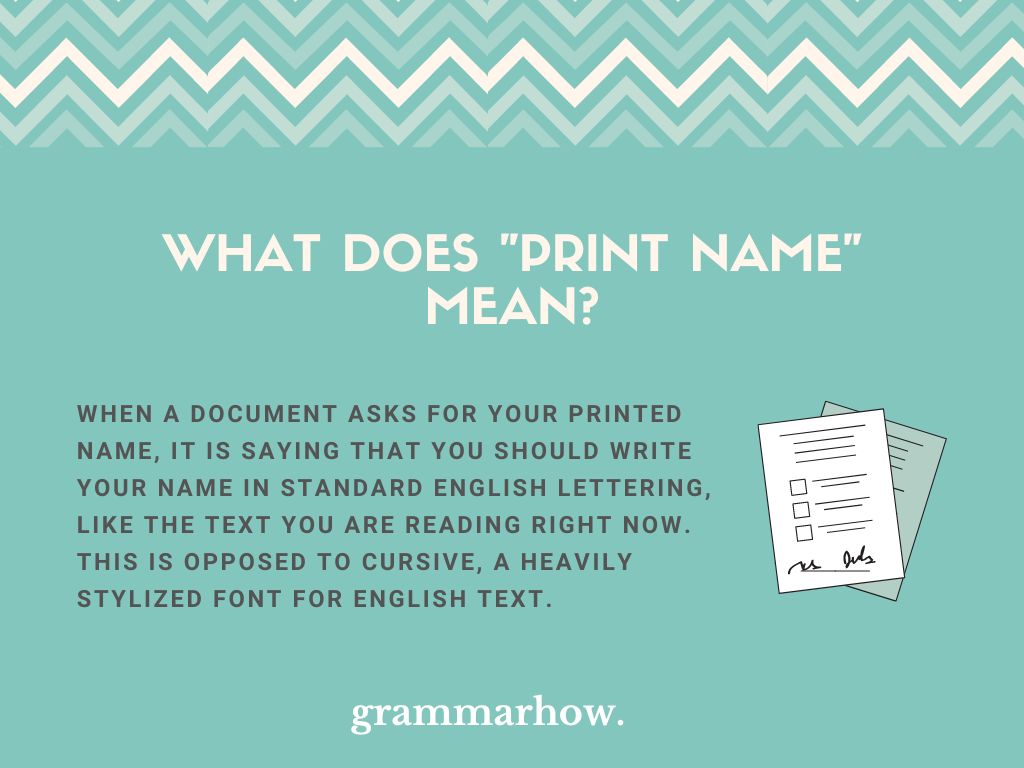Chances are, you’ve had to write your signature on a form before. In such a scenario, you may have been asked to sign your “printed name”. What exactly does that mean? How is it different from your name any other time?
We are going to answer that question in this post.
What Does “Print Name” Mean?
When a document asks for your printed name, it is saying that you should write your name in standard English lettering, like the text you are reading right now. This is opposed to cursive, a heavily stylized font for English text.

Depending on when you went to school or what you learned there, you may remember being taught how to write in cursive. You may have been told that it was useful to know in real life, but lo and behold, it is barely used. At best, cursive is used for signatures.
However, many official documents need both your personal signature, which can be stylized, and your printed name, which is written exactly like you see here. It’s called “print” because you are writing the letters in the style that you would see in printed material like books or magazines.
Furthermore, when you are signing a form, your printed name should almost always be completely capitalized. If you’re still confused, don’t worry; we have an example for you down below. Compare the two ways the following name is written:
- JOHN SMITH
- John Smith
The first style would be considered “print”. This is how you are expected to write your name when a form asks for your “printed name”. The second style, while very fancy looking, is not print, and is not what is expected. Any style besides standard, capitalized English lettering is not acceptable.
If you are asked for your printed name, write it out as though you were typing it on a computer; it should look just like the text you see here, but completely capitalized.
Examples of How to Write “Print Name” on Forms
There are many ways to write your printed name on a form. However, it usually depends on what type of form you are signing. For instance, all of the below examples can be correct depending on the document being signed:
- John Smith
- Mr. Smith
- JOHN SMITH
- William John Smith
- William J. Smith
Generally speaking, the safest option is to write out your full name, including a middle name (or a suffix like Jr.) if you have one, completely capitalized. This is how most official government or business forms would prefer for you to sign your printed name.
That’s because there is absolutely no room for error or confusion when you write out your entire name in all capital letters. The person reading the form is less likely to confuse you with someone else or misread your completely capitalized name.
This does not mean you can never use the other ways of writing your name. However, you run the risk of potentially not meeting the expectations of the form with the other methods. This is just the safest choice.
Can “Print Name” Be Typed?
Your printed name can be typed if the document you are being asked to sign is digital. If, for some reason, you were expected to physically print out the form and then sign it, explicit instructions telling you to do that would almost certainly be provided to you.
You can sign your printed name with handwriting or typing, it just depends on how the form is provided.
Print Name vs. Printed Name
The terms “print name” and “printed name” are synonymous. They mean the same thing, they are just slightly different spellings. Both are requesting you to write your name in standard text with no special alterations to format or style.
Why Is “Print Name” Included in Forms?
Your printed name is required on forms for record keeping purposes.
Your signature can often be hard to read depending on your hand-writing. Most official forms need to know your name without any errors, so they also request your name in print so there is no room for error or confusion.
This is very important in government records.

Martin holds a Master’s degree in Finance and International Business. He has six years of experience in professional communication with clients, executives, and colleagues. Furthermore, he has teaching experience from Aarhus University. Martin has been featured as an expert in communication and teaching on Forbes and Shopify. Read more about Martin here.
